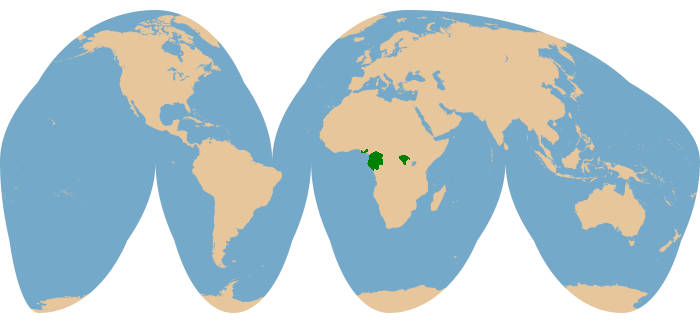Kingdom: |
Animalia Chordata Mammalia Artiodactyla Ruminantia Bovidae Antilopinae Neotragini Neotragus |
Common name:
Scientific name:
Other names: |
Bates's pygmy antelope
Neotragus batesi
Dwarf antelope, Néotrague de Bates |
Physical Characteristics
- Head and body length:
50-60 cm
- Shoulder height: 30 cm
- Tail length: 9 cm
- Adult weight: Females average 2.5-2.8 kg; males average 2.2-2.3 kg
- Shoulder height: 30 cm
Female Bates's pygmy antelope are typically larger than males. The body has a hunched, forward-sloping form, with the shoulders lower than the rump. The legs are very slender, and are marked with white spots just above the hooves. Dewclaws are always absent. The coat is an overall glossy dark reddish-brown; the underparts are whitish. The short tail is entirely brown on both its upper and lower surfaces. The face is coloured similarly to the body, although the forehead tends to be darker; this is accentuated by small white markings at the base of the ears, and by the white chin and upper throat. Only the males carry horns, which are very short - typically 2-4 cm (up to 5.5 cm) in length. The horns have rings at the base, and project straight backwards in line with the forehead.
- Similar species
- Bates's pygmy antelope is physically similar to the royal antelope (Neotragus pygmaeus) from west Africa, but can be distinguished by its range, as well its slightly larger size, darker colouration, and the presence of small black-and-white markings on the ears.
Reproduction and Development
- Gestation period:
Estimated to be ~210 days.
- Litter size: One.
- Weaning: Presumably after 3-4 months.
- Sexual maturity: Females at 16 months, males may begin showing signs of maturity at 8 months but continue to mature until 18 months of age.
- Life span: Unknown.
- Litter size: One.
Bates's pygmy antelope breeds year round, with notable peaks in births in Gabon in April and from October to December. Young are approximately 500 g at birth.
Ecology and Behavior
Bates's pygmy antelope are active throughout the day and night, with peaks of activity around dawn and dusk. The day is typically spent in dense forest, while foraging in more open habitats occurs at night. This antelope is rarely found far from dense cover, which it uses as a refuge from predators. When foraging, Bates's pygmy antelope travels with its head close to the ground, lifting its feet and placing them down carefully. If startled, the initial response is to freeze in position, followed by immediate flight into cover if a threat is detected. This species inhabits small home ranges (1-3 hectares in size for females, 2-4 hectares for males), and patterns of use vary seasonally. Males mark their ranges with secretions from their preorbital glands, leaving black marks on the tips of branches. While the range of one male may overlap those of several females, male home ranges tend not to overlap - however, it has not been ascertained whether they are truly territories. Typical population densities have been estimated at 1.5-2.2 animals per km2, although in favourable habitats they may exceed 35 per km2.
- Family group:
Solitary. This species is occasionally seen in pairs, but it is unknown if these are social associations or simply proximity while feeding.
- Diet: Leaves of herbaceous plants, seedling trees, ferns, and vines.
- Main Predators: A wide range of predatory species.
- Diet: Leaves of herbaceous plants, seedling trees, ferns, and vines.
Habitat and Distribution

Conservation Status
- IUCN Red List:
Least concern (2016).
- CITES Listing: Not listed (2017).
- Threats: Bushmeat hunting, habitat disturbance.
- CITES Listing: Not listed (2017).
Based on density estimates, the total population is at least 219,000 individuals and is believed to be stable. As an edge species, Bates's pygmy antelope is able to colonize plantations and other areas inhabited by humans, although increased colonization also brings increased hunting threats.


